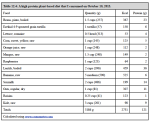Mobility Assessment
This mobility assessment will help you determine where you will need to focus on remedial mobility exercises to improve your strength training.
This mobility assessment focuses on functional mobility for full range strength training. You will evaluate your mobility in the following basic ranges of motion:
1. Full squat: The full squat tests ankle dorsiflexion and hip flexion range of motion. You will perform two assessments for the full squat.
2. Pike position: Pike position tests hamstring, hip and lumbar spine range of motion in forward flexion at the waist.
3. Active spinal extension: This tests the most basic level of lumbar spine and rectus abdominus extension.
4. Active shoulder flexion: This tests your ability to access the full range of shoulder flexion.
5. Active shoulder extension: This tests your ability to access the full range of shoulder extension.
Full Squat Mobility Assessment #1
The full squat is a basic human movement. In primal cultures it is a resting position. To develop your full physical potential, you must reclaim your ancestral ability to hold a full squat for extended periods of time.
If you want great strength, you must incorporate barbell loaded squatting in your training. The better your squat mobility, the deeper you can squat without hazard, and the stronger you will get.
The first deep squat mobility assessment consists of assuming a deep squat position and assessing both the depth you can achieve and the length of time you can hold the deep position. Do it this way:
|
1. Place bare feet shoulder width apart and parallel. 2. You may hold a 10-20 pound counterweight in your hands as shown to the right. 3. Squat as deeply as you can without allowing your feet to turn out. 4. Hold as long as you can and time it. Goals: 1. Hips below knees. 2. Hamstrings in contact with calves. 3. Able to hold for 1 minute minimum. You should aim to develop the ability to stay in this position for 15 minutes. |
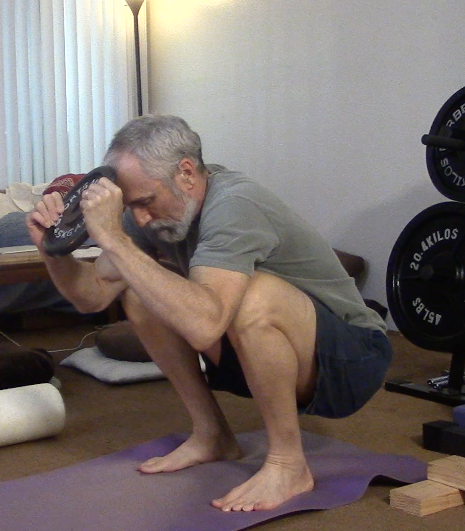 |
If you can't achieve these standards, start squatting like this every day (with the counterweight), gradually building up to 15 minutes per squat. Your body will gradually reclaim its ability to squat properly.
Full Squat Mobility Assessment #2
This assessment tests your ankle and hip mobility in a lunge position. To perform this assessment, you need to position your toes 5" from a wall. I recommend getting two 2 x 4 boards, each 2 feet long, and stack them against the wall as shown below.
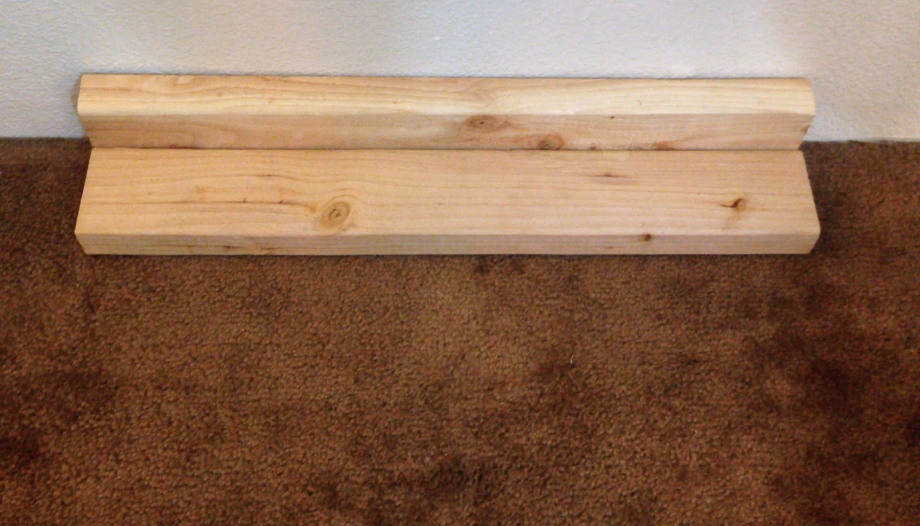
This will keep your foot 5" from the wall and also prevent it from slipping forward closer to the wall.
Now you place the big toe of one of your bare feet right up against the board, and, in a lunge position and keeping your heel firmly on the floor, you attempt to touch the wall with your knee, as shown below.
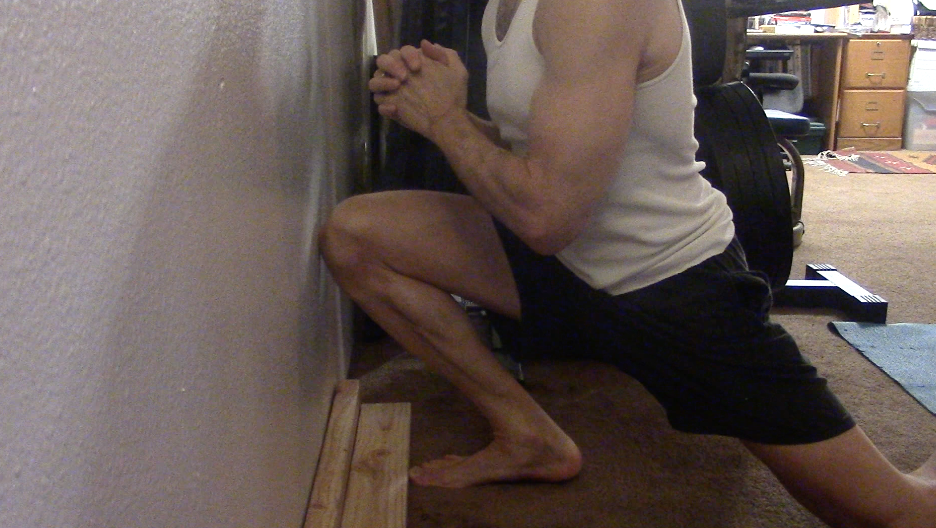
If you can't touch your knee to the wall, you need to work on your ankle and hip mobility. In the following video I demonstrate the exercises that I have found useful for improving my ankle mobility to achieve the knee-to-wall position shown above:
I recommend performing this routine as part of your warm up routine before doing barbell squats.
Pike Mobility Assessment
The pike position, also called forward bend, tests your range of motion in spinal and hip flexion. It requires lower back, hip, and hamstring mobility. Like the squat, a forward bend is a basic human movement.
To test your forward bend ability, you do what some call the "sit and reach" test.
Sit on the floor or a mat, and while keeping your knees straight and legs parallel, reach toward your feet.
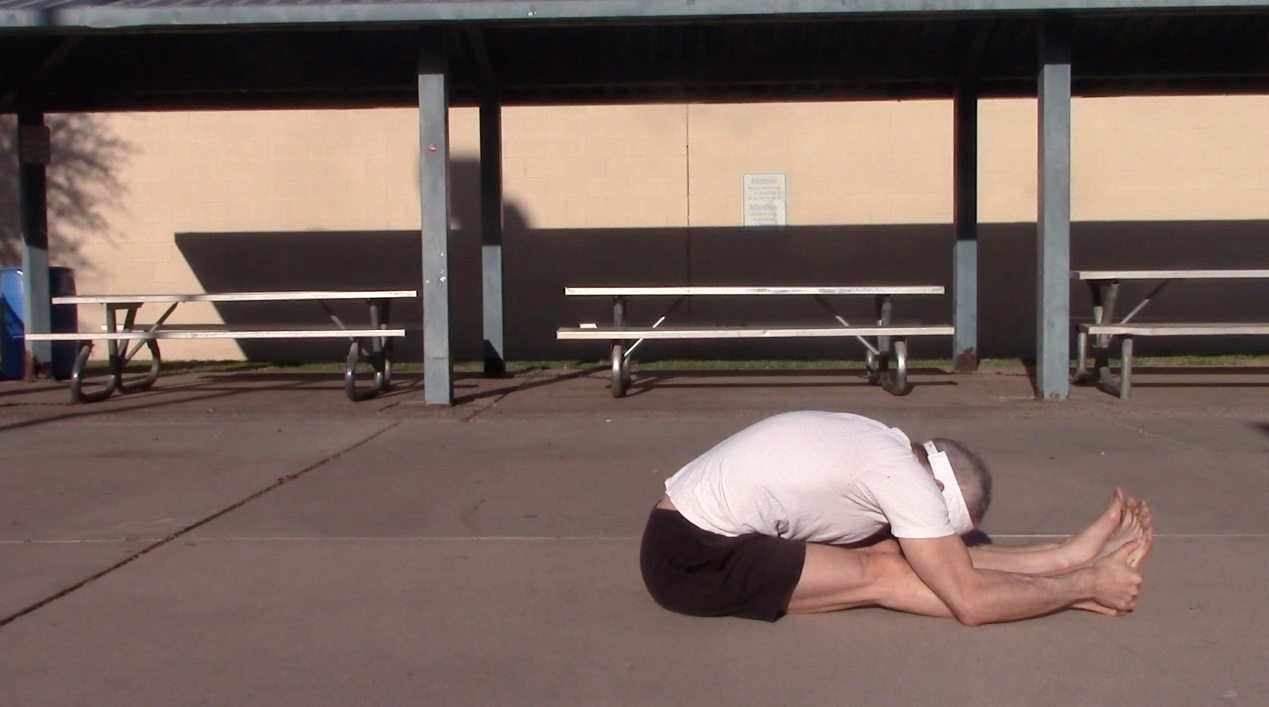
If you can't reach beyond your toes, you need to work on hip and hamstring flexibility. To work on this range of motion, incorporate the exercise known as Jefferson Curls as part of your regular training.
Key points:
1. Do this exercise as part of your mobility training and cool down after your strength training.
2. Start with a very light weight, such as just a wooden dowel.
3. Keep buttocks tight during whole movement.
4. Always move slowly and smoothly. A set of 5 or 6 repetitions should take 60-90 seconds.
5. On the last repetition, remain in the forward bend position for 10-20 seconds before slowly reversing direction.
6. The load should always feel easy to manage. Never use a load requiring great effort to move.
7. Increase load very slowly, such as 5 pounds biweekly initially, after 20 weeks decreasing to 5 pounds per month.
Active Spinal Extension Mobility Assessment
This test evaluates your spinal extension mobility.
1. Lie prone on the floor or a mat with arms at your sides.
2. Keeping your eyes facing forward (not up at the ceiling), slowly lift your torso from the floor as high as possible.
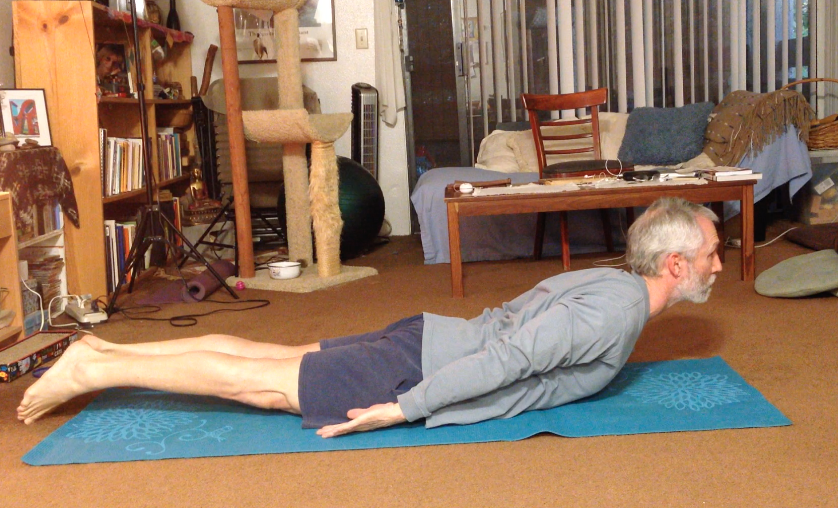
The minimum standard is to have your chin 6" off the floor when fully extended. To improve your spinal extension mobility, incorporate back arch ups on a Roman chair into your strength routine.
Active Shoulder Flexion Mobility Assessment
You need good shoulder flexion mobility to develop great strength in the overhead press or handstands.
1. Lie prone on the floor or a mat.
2. Stretch your arms overhead, palms facing the floor.
3. Keeping your elbows straight and chin on the floor, raise your palms off the floor.
I have demonstrated this movement using a wooden dowel loaded with small weights in the video below.
Standards:
1. Arms parallel overhead.
2. Elbows straight.
3. Chin remains on the floor; arms travel but head does not.
4. Both palms reach the same elevation.
If you fail to meet these standards, perform the exercise demonstrated above as part of your regular training, starting with an empty bar, and gradually adding load, just one pound at a time. Film yourself or have a training partner evaluate the other form points. Perform a single set of 6 repetitions of this exercise as part of your warm up or cool down.
Active Shoulder Extension Mobility Assessment
You need good shoulder extension mobility to prevent shoulder injuries resulting from heavy training of the bench press, parallel bar dips, or weighted pushups.
1. Hold a 1" x 3'-4' hard wooden dowel behind your back with palms facing forward.
2. Keeping the torso upright, lift the bar as high as possible behind your back.
Standards:
1. Arms reach at least an 80º and preferably a 90º to the torso with the torso remaining upright.
2. Both arms reach the same elevation without any twisting or leaning of torso.
You can use this movement in your regular training to improve your shoulder extension range of motion.
1. Start with an empty dowel.
2. Raise the bar to full extension and hold for 5 seconds.
3. Lower and repeat 6 times.
Use only the empty bar until you can raise the arms to at least 80º to the torso. Then add small amounts of weight, starting with just 0.5 to 1.0 pound. Do not use heavy loads that reduce your range of motion. Perform this exercise as part of your warm up or cool down.
Recent Articles
-
Ancient Roman Soldier Diet
Apr 14, 25 05:19 PM
A discussion of the ancient Roman soldier diet, its staple foods and nutritional value, and a vegan minimalist version. -
High Protein Chocolate Tofu Pudding
Jul 01, 24 12:41 PM
A delicious high protein chocolate tofu pudding. -
Vegan Macrobiotic Diet For Psoriasis
Sep 05, 23 06:36 PM
Vegan macrobiotic diet for psoriasis. My progress healing psoriasis with a vegan macrobiotic diet. -
How Every Disease Develops
Aug 04, 23 06:22 PM
How every disease develops over time, according to macrobiotic medicine. -
Why Do People Quit Being Vegan?
Jun 28, 23 08:04 PM
Why do people quit being vegan? How peer pressure and ego conspire against vegans. -
Powered By Plants
Mar 16, 23 08:01 PM
Powered By Plants is a book in which I have presented a lot of scientific evidence that humans are designed by Nature for a whole foods plant-based diet. -
Carnism Versus Libertarianism
Dec 30, 22 01:55 PM
Carnism Versus Libertarianism is an e-book demonstrating that carnism is in principle incompatible with libertarianism, voluntaryism, and anarchism. -
The Most Dangerous Superstition Book Review
Nov 15, 22 08:46 PM
Review of the book The Most Dangerous Superstition by Larken Rose.


